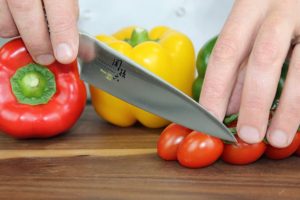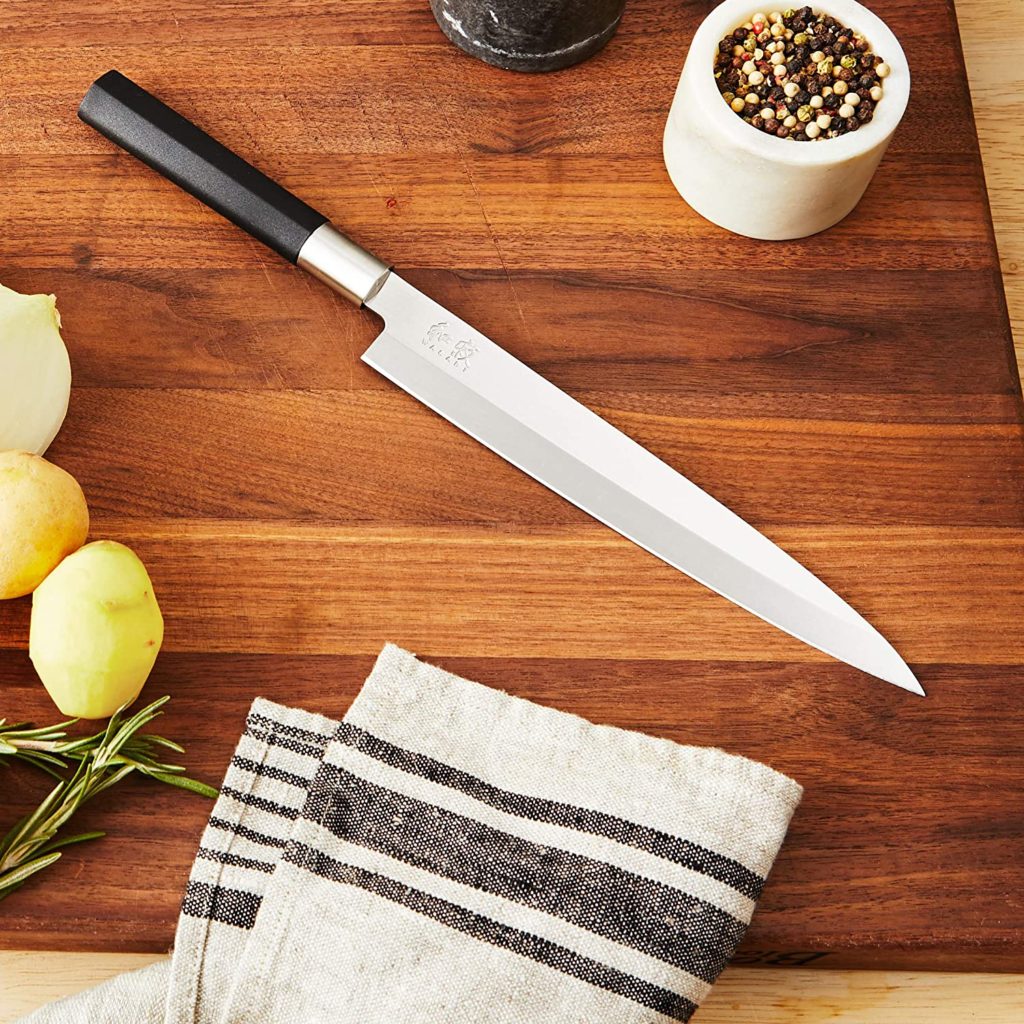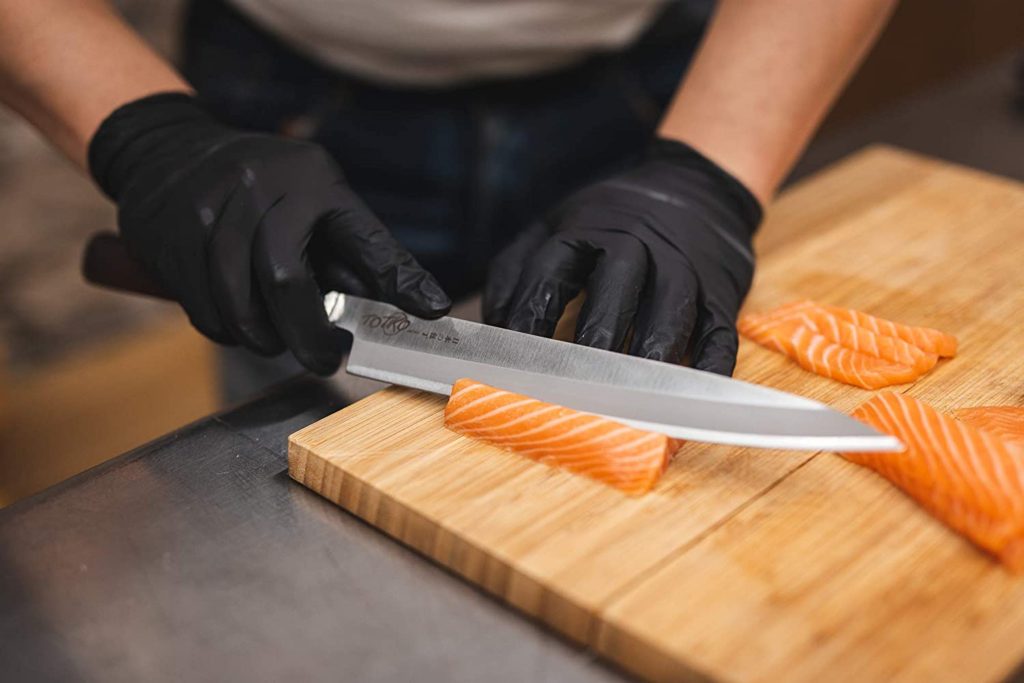
When you work in Japanese restaurant, first thing you need is KNIFE.
There are so many kinds of knives in our market right now. It is difficult to choose what is best for you if you just started working.
When I started working in the kitchen, I was still using the knives which my school had given me.
I learnt about knives whilst growing up in the kitchen, asking senior chefs what is better for what.
Hope this article would helps you to choose some for your work. Every knife idea is from my 15 years of experience as a professional Japanese chef.
What to choose Japanese Knives for a professional chef
1, Santoku Knife
The Santoku bōchō (三徳包丁) or Bunka bōchō (文化包丁) is a general-purpose kitchen knife originating in Japan. Its blade is typically between 13 and 20 cm (5 and 8 in) long, and has a flat edge and a sheepsfoot blade that curves down an angle approaching 60 degrees at the point. The term Santoku may refer to the wide variety of ingredients that the knife can handle: meat, fish and vegetables, or to the tasks it can perform: slicing, chopping and dicing, either interpretation indicating a multi-use, general-purpose kitchen knife. The Santoku’s blade and handle are designed to work in harmony by matching the blade’s width and weight to the weight of the tang and the handle. (From Wikipedia)
<三徳包丁>
- Most common knife in Japan as for home kitchen and professional kitchen.
- Suitable for cutting vegetables, meats and fishes.
- Normally sized about 15cm to 20cm
- This knife Sekimagoroku (関孫六) in the left is particularly difficult to blunt yet easy to sharpen and rust-resistant. I personally love it. Highly recommend!
- The Shun (旬)Premier Tim Mälzer Series has been tailored specifically to the needs and requirements of professional chefs.
- Handle length is 12cm and made from walnut is very easy to grip.
- The blade is finished with a highly-polished precision cutting edge.
2, Petty Knife
For me, I don’t really use petty knife in my kitchen but sometimes it’s very good for all small kitchen tasks, peeling, cutting fruit and small delicate kitchen work. If you are working as a pastry chef, it is very useful and must-have one.
<ペティナイフ>
- Normally sized from 8cm to 12cm
- Good for all those small kitchen tasks, peeling, cutting fruit and small delicate kitchen work.
3, Usuba(薄刃)
Usuba(薄刃包丁)or Nakiri(菜切包丁)mostly cutting for vegetables. The general size ranges from 16cm ~20cm. The square tip makes the knife feel more robust and secure than the pointed tip of the santoku and gyuto. Commonly the blade for this is one side edge in Japan but it depends what brand you choose, some of them are both side edge.
<菜切り包丁>
- A specialist vegetable knife.
- This Kasumi(霞)hammered 17cm nakiri knife features a very straight blade to give you a clean cut through vegetables.
- This is stainless blade so easy to maintenance.
- This Nakiri knife on the left is double edge bevel with the blade bevel flat on the left side.
- The spine is quite thick – this makes slicing through thick vegetables challenging as the blade tends to push apart the individual slices.
- But perfect length for most of the vegetables especially for roots veges.
4, Yanagiba(柳刃)
The most popular knife for cutting fish, also known as shobu-bocho (sashimi knife). It is used to highlight different textures of fish in their techniques: hirazukuri to pull cut vertically, usuzukuri to pull cut thin vertically, and sogizukuri to pull cut at an angle. It is used to skin and sometimes scale and de-bone certain fish (for instance salmon). (:from Wikipedia)
<柳刃>
- Suitable for cutting ultra-thin slices dishes such as sashimi, sushi.
- This Unique, single-sided blade design, made with Daido 1K6 high-carbon, stainless steel so easy to maintain.
- The blade is 21cm, not too long size for having as a first Yanagiba knife and also this model (Wasabi-和寂-) weigh is particularly very light.
- This 30cm blade knife is more like for a professional and an experienced chef.
- But great to prepare fresh fish like sushi and sashimi.
- High-carbon steel blade; hardness: 58HRC, for better resistance.
- This particularly remain sharp considerably longer than cheaper knives, but are a lot more difficult to sharpen.
5, Deba(出刃)Knife
Thick knives to cut through resilient fish flesh for fillet and to cut through rib bones, behind the head, and through the head. They are 5mm to 9mm thick depending on size. The general size is about 12cm~21cm, There are variety of sizes you can choose according to the size of the fish or meat.
<出刃包丁>
- Imported from Japan.
- Traditional wooden handle.
- Total length of 33cm is perfect for filleting fish.
- This model(sabun) made from white-steel so it has to be careful to maintain.
- This is actually very good one. Too cheap for this quality.
- AUS-8 Japan steel, one side edge, well it resists rust and how easily is sharpens.
- Size 17cm is good to handle for elementary or intermediate chefs for filleting.
Conclusion
- I highly recommend to buy a Santoku knife, if you are new to work in professional kitchen.
- A must buy a Yanagi-knife, if you work as a sushi chef.
- You need to be careful with the sizes when you buy one. the longer the more experienced.







